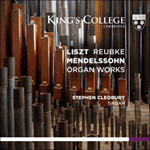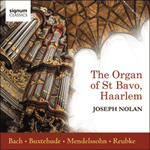
Welcome to Hyperion Records, a British classical label devoted to presenting high-quality recordings of music of all styles and from all periods from the twelfth century to the twenty-first.
Hyperion offers both CDs, and downloads in a number of formats. The site is also available in several languages.
Please use the dropdown buttons to set your preferred options, or use the checkbox to accept the defaults.
In common with Meyerbeer, Mendelssohn’s posthumous reputation in the country of his birth suffered from Wagner’s pen (this time through the faintest of praise rather than vitriol) and, in due course, the Nazi regime’s efforts to expunge his name from musical history. In England, where Mendelssohn had made a strong impression on musical life over the course of ten visits, his stock remained considerably higher. Mendelssohn enjoyed particular success with his organ recitals in the late 1830s and early 1840s, leading the publishers Coventry and Hollier to commission a set of six “voluntaries” from him in 1844. The planned voluntaries soon became Mendelssohn’s six Organ Sonatas Op 65, with the term sonata here implying the Bachian sense of the term—i.e. suites of varied pieces which are played instrumentally, as opposed to sung cantatas—rather than works exhibiting classical sonata form. The Organ Sonata No 6 in D minor (1845) demonstrates Mendelssohn’s consummate craftsmanship and mastery of organ texture in a set of variations upon the Lutheran Bach chorale Vater unser im Himmelreich (BWV416). Following a five-part harmonisation of the Chorale, which pervades the sonata as a whole, Mendelssohn presents four variations of increasing brilliance before a restatement of the Chorale. The sonata concludes with a substantial fugue and the finale in D major, whose quiet religiosity symbolises the completion of a journey from stern Lutheranism to an essentially English brand of sentiment. In this work and its companion sonatas, Mendelssohn revitalised the then-moribund European organ tradition, spurred English organ-builders to new heights, and, through his particular blend of chorale, counterpoint and domestic spirituality, substantially augmented the organ repertoire for the first time since Bach. Musing on his passion for structural innovation, Liszt once remarked that “new wine demands new bottles”; Mendelssohn here demonstrates the continued potency of an older brew.
from notes by Conor Farrington © 2015
Comme pour Meyerbeer, la réputation posthume de Mendelssohn dans son pays natal fut mise à mal par la plume de Wagner (davantage cette fois par des compliments ambigus qu’une attaque au vitriol) et, par la suite, par les efforts du régime Nazi pour rayer son nom de l’histoire de la musique. En Angleterre, où Mendelssohn se rendit une dizaine de fois et où son influence sur la vie musicale fut considérable, sa célébrité ne se démentit pas. Ses récitals de la fin des années 1830 et du début des années 1840 en particulier lui valurent un immense succès, ce qui conduisit les éditeurs Coventry et Hollier à lui commander en 1844 six “voluntaries”, qui devinrent finalement les six Sonates pour Orgue op. 65. Le terme “sonate” est ici à entendre au sens que lui donna Bach—une suite de pièces instrumentales, par opposition aux cantates chantées, plutôt que des œuvres composées selon les règles classiques de la forme sonate. La Sonate pour Orgue no 6 en ré mineur (1845) montre la maîtrise talentueuse qu’avait Mendelssohn des spécificités de l’instrument, dans une série de variations sur le choral de Bach, Vater unser im Himmelreich (BWV416). Après une harmonisation en cinq parties du thème choral qui influence la structure entière de la sonate, quatre variations se font entendre, chacune plus brillante que la précédente, avant une réexposition du choral. La sonate se conclut sur une large fugue et un final en ré majeur, dont la religiosité tranquille symbolise l’achèvement du voyage qui mène du Luthéranisme rigoureux à des sentiments résolument “anglais”. Dans cette sonate (comme dans celles qui l’accompagnent), Mendelssohn revitalisait la tradition organistique alors moribonde, conduisant les facteurs anglais à de nouveaux sommets, et par son mélange personnel de choral, de contrepoint et d’une spiritualité familière, il développait le répertoire de l’instrument pour la première fois depuis Bach. Liszt déclara un jour, au sujet de sa propre passion pour l’innovation: “un vin nouveau demande de nouvelles bouteilles”; Mendelssohn nous démontre la puissance permanente des anciens breuvages.
extrait des notes rédigées par Conor Farrington © 2015
Français: Gildas Tilliette
Wie Meyerbeers wurde auch Mendelssohns Ruf nach seinem Tod in seiner Heimat durch Wagner nachhaltig geschädigt (in diesem Fall eher durch sehr zurückhaltendes Lob als durch Gehässigkeit) und schließlich durch den Versuch der Nationalsozialisten, seinen Namen ganz aus der Musikgeschichte zu tilgen. In England, wo Mendelssohn aufgrund seiner zehn Besuche einen tiefen Eindruck hinterlassen hatte, stand er in weit höherem Ansehen. Besonders große Erfolge feierte er Ende der 1830er- und Anfang der 1840er-Jahre mit seinen Orgelrecitals, die den Verleger Coventry and Hollier 1844 veranlassten, einen Satz von sechs voluntaries (Orgelsoli) bei ihm in Auftrag zu geben. Dieses Projekt entwickelte sich allerdings sehr bald zu seinen sechs Orgelsonaten op. 65. Der Begriff „Sonate“ muss hier im Bachschen Sinne verstanden werden—das heißt, Suiten abwechslungsreicher Stücke, die instrumental gespielt werden, keine gesungenen Kantaten—, man darf also keine Musik in klassischer Sonatenform erwarten. Die Orgelsonate Nr. 6 in d-Moll (1845) veranschaulicht in einem Satz Variationen über den Bach-Choral Vater unser im Himmelreich (BWV416) Mendelssohns meisterliche Beherrschung der Orgelklangfarbe. Auf eine fünfteilige Harmonisierung des Chorals, der die gesamte Sonate durchzieht, folgen vier Variationen von steigender Brillanz, ehe der Choral erneut erklingt. Die Sonate endet mit einer ausgedehnten Fuge und dem Finale in D-Dur, dessen stille Religiosität den Endpunkt einer Reise vom strengen Protestantismus zu einem letztlich sehr englischen Gefühl bildet. Mit diesem Werk wie auch mit den anderen fünf Sonaten belebte Mendelssohn die damals fast vergessene europäische Orgeltradition, regte englische Orgelbauer zu neuen Höhen an und erweiterte durch seine ganz eigene Mischung von Choral, Kontrapunkt und häuslicher Spiritualität zum ersten Mal seit Bach beträchtlich das Orgelrepertoire. Liszt bemerkte einmal: „Neuer Wein braucht neue Flaschen“, doch Mendelssohn führt hier die anhaltende Ausdruckskraft eines gereiften Jahrgangs vor Augen.
aus dem Begleittext von Conor Farrington © 2015
Deutsch: Ursula Wulfekamp
 Liszt, Reubke & Mendelssohn: Organ Works Liszt, Reubke & Mendelssohn: Organ WorksPerforming three popular virtuosic works for the organ, Stephen Cleobury demonstrates the power of the great Harrison & Harrison organ set within the chapel of King’s College, Cambridge.» More |
 The organ of St Bavo, Haarlem The organ of St Bavo, HaarlemHoused in one of the most spectacular organ cases in the world, the colourful 1738 Christian Müller organ of St Bavo in the Dutch city of Haarlem is the perfect instrument for this all-German programme featuring works by Bach, Buxtehude and Mendel ...» More |

